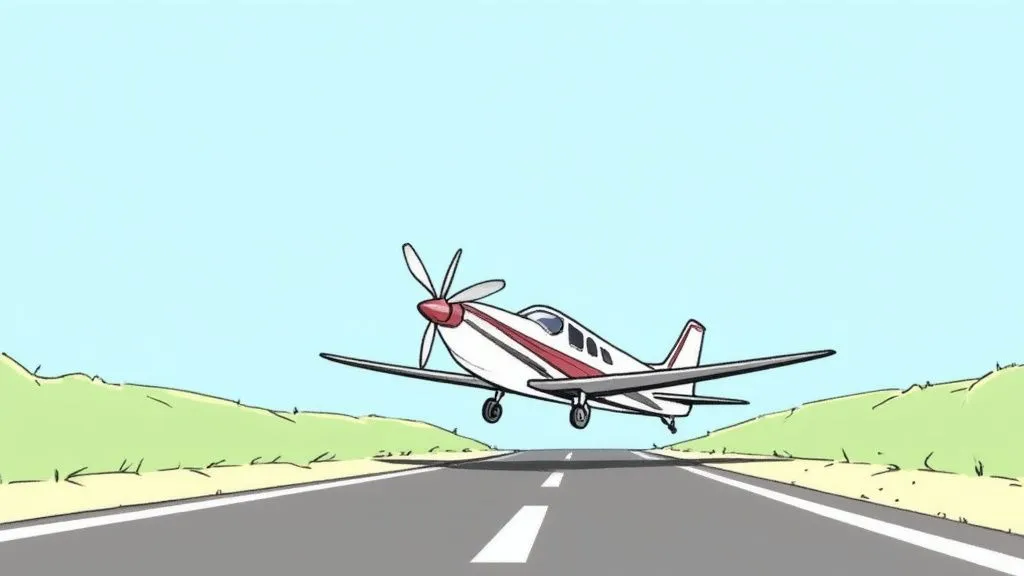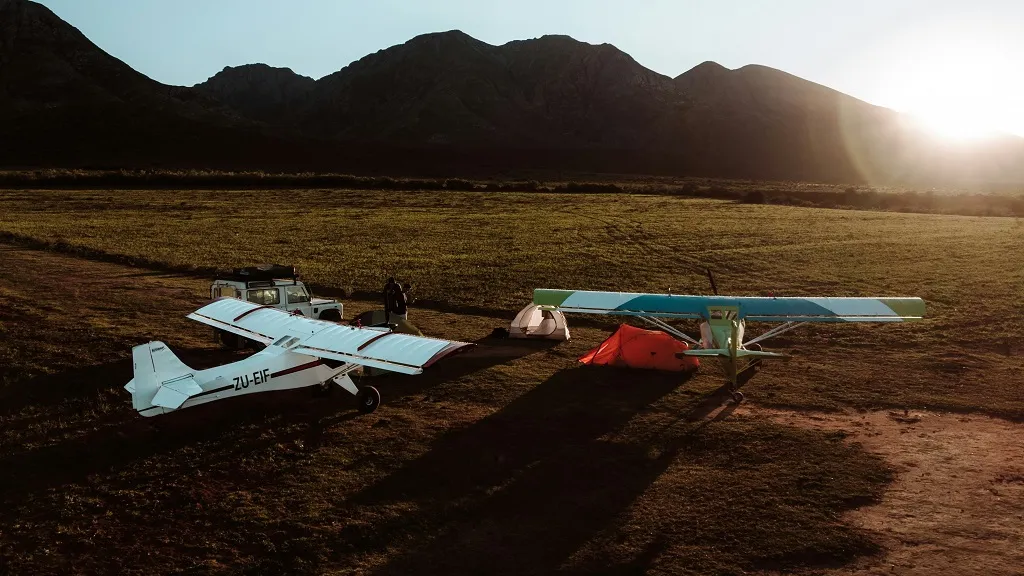Understanding What Makes Short Field Takeoffs Different
Short field takeoffs present a unique challenge for pilots, requiring a precise combination of skill, knowledge, and aircraft control. Unlike standard takeoffs with ample runway length, short field takeoffs demand maximizing aircraft performance within limited space. This requires pilots to carefully manage the factors that influence takeoff distance.
The Crucial Role of Aerodynamics
Understanding aerodynamics is fundamental to a successful short field takeoff. The relationship between airspeed, angle of attack, and ground roll distance becomes critically important. A higher angle of attack generates increased lift at lower speeds, essential for becoming airborne quickly. However, exceeding the critical angle of attack can result in a stall.
Finding the right balance is the key. It’s like a carefully balanced scale. You need enough lift to take off, but not so much that the aircraft stalls.
Aircraft Configuration: Every Detail Matters
The aircraft’s configuration plays a significant role in its short field performance. Key factors include:
- Flap Setting: Correct flap settings increase lift at lower speeds, shortening the takeoff roll. Too much flap, though, can create drag and hinder acceleration.
- Weight and Balance: A lighter aircraft accelerates faster and requires less runway. Proper weight distribution ensures stability during the takeoff run.
- Trim: Correct trim settings reduce pilot workload and help maintain the desired angle of attack during the initial climb.
These seemingly small details combine to optimize the aircraft for a rapid liftoff, extracting maximum performance from the limited runway. For instance, even a slight increase in weight can noticeably affect takeoff distance.
Historical Context and Modern Advancements
Interestingly, short field takeoffs have a long history. A core feature of bush and utility aircraft, short field takeoff safety and performance have greatly improved since the mid-20th century. Aircraft like the Piper PA-18 Super Cub and the Cessna 180, popular in the 1950s and 1960s, were designed for short field operations, often taking off in 200-300 feet. Thanks to advancements in wing design and engine technology, some modern STOL (Short Takeoff and Landing) aircraft can now take off in under 100 feet. (Learn more about this evolution here.)
Precision: The Defining Factor
Precision in every stage of the takeoff sequence is paramount. From the initial throttle application to the final rotation, accurate control inputs are essential. This is where the line between a safe takeoff and a potential accident is drawn. Mastering these techniques and understanding the underlying physics form the basis for safe and efficient short field takeoffs.
How Weather And Conditions Impact Your Performance
Understanding how weather affects aircraft performance is crucial for safe short field takeoffs. Temperature, humidity, and barometric pressure all influence engine power and lift. Even small changes can significantly increase your required takeoff distance, impacting safety.
Density Altitude: The Invisible Factor
Density altitude is a critical concept for pilots. It combines temperature, humidity, and pressure altitude to represent air density. Higher density altitudes mean thinner air, resulting in less engine power and reduced lift.
This explains why the same aircraft might need a much longer takeoff roll on a hot, humid day at a high-elevation airport compared to a cool, dry day at sea level. Think of it like running uphill through thick air versus running downhill through thin air. The effort required changes significantly.
The Impact of Temperature and Humidity
Temperature and humidity directly affect density altitude. Higher temperatures and increased humidity both decrease air density. This means the engine has less air for combustion and the wings have less air to generate lift. The result is a longer takeoff roll and a slower climb rate – two critical factors in short field takeoffs.
Barometric Pressure’s Role
Barometric pressure also plays a role in density altitude. Lower pressure equates to less dense air, hindering performance. It’s like trying to inflate a balloon at the top of a mountain; it takes more effort because the air pressure is lower. Similarly, an aircraft needs more runway to achieve lift in lower-pressure environments.
Runway Surface Considerations
Besides atmospheric conditions, the runway surface itself significantly affects short field takeoffs. Different surfaces offer varying levels of friction.
- Paved Runways: Provide good friction and predictable performance.
- Grass Strips: Offer reduced friction, increasing the takeoff roll and requiring more precise control.
- Contaminated Surfaces: Snow, ice, or water significantly reduce friction, potentially making a short field takeoff unsafe and requiring careful evaluation.

To better understand how these conditions impact takeoff distances, let’s compare different conditions:
Environmental Impact on Takeoff Distance
| Condition | Sea Level Distance | 5,000ft Elevation | Performance Impact |
|---|---|---|---|
| Standard Temperature & Pressure | 700 ft | 1,050 ft | +50% |
| High Temperature & High Humidity | 900 ft | 1,450 ft | +61% |
| High Elevation & Low Pressure | 850 ft | 1,350 ft | +59% |
Note: These are example figures and can vary significantly based on aircraft type and specific conditions.
As you can see, the impact of environmental conditions, particularly at higher elevations, dramatically increases takeoff distances.
The combined effects of these environmental and operational variables are considerable and supported by statistical analysis. Factors like air temperature, runway surface, elevation, and wind direction all play a role. At high-elevation airports (above 5,000 feet), the same aircraft may require 50% to 100% more runway due to the lower air density and reduced engine power.
For more information, check out this resource: Takeoff and Landing Performance. Also, consider brushing up on your weather briefing skills: How to Master Weather Briefings.
Building Personal Minimums: A Safety Net
Because of the many interacting factors affecting short field takeoffs, developing personal minimums is vital. These self-imposed limits, based on your experience, skill level, and comfort zone, help you decide when conditions are safe. They also guide you on when to wait for better conditions or choose a different runway. By incorporating these factors, you enhance both safety and flexibility.
Mastering The Step-By-Step Takeoff Sequence
While understanding the basics of takeoff procedures is essential, subtle differences distinguish a safe short field takeoff from a potentially dangerous one. This section explores the precise techniques used by seasoned bush pilots to consistently achieve maximum performance in the shortest distances. These techniques can be the difference between a safe takeoff and an accident.
Initial Steps: Setting the Stage for Success
The initial steps in a short field takeoff are crucial for a successful maneuver. Start by configuring the aircraft for the specific conditions. This includes setting flaps to the recommended short field takeoff setting, verifying proper trim, and confirming the weight and balance.
Next, position the aircraft on the runway centerline. Apply full throttle smoothly and quickly to maximize acceleration. Maintaining directional control with rudder input is vital during this initial acceleration phase.
Rotation: The Critical Moment
As the aircraft accelerates, it will reach rotation speed (Vr). This is the speed at which the aircraft can safely lift off. Recognizing Vr and initiating rotation at the correct moment is essential for a successful short field takeoff. Rotation involves smoothly applying back pressure on the control column or yoke to lift the nose wheel. Over-rotating and lifting off too early, however, can result in a loss of airspeed and a potential stall.
Maintaining Control After Liftoff
Once airborne, maintaining control and optimizing the initial climb becomes the priority. After liftoff, maintain a safe climb speed (Vy). This ensures optimal climb performance and minimizes the risk of stalling.
Read also: What are the V-speeds in aviation?
Adjust the pitch attitude to achieve Vy, using smooth control inputs to maintain a stable climb. As the aircraft gains altitude and airspeed, gradually retract the flaps according to the aircraft’s operating manual.

Common Errors and How to Avoid Them
Even experienced pilots can make mistakes during short field takeoffs. Common short field takeoff errors include:
- Incorrect flap settings: Too little flap increases the takeoff roll, while too much flap can create excessive drag.
- Rotating too early: This can cause a dangerous loss of airspeed close to the ground.
- Failing to maintain directional control during the takeoff roll can lead to a runway excursion (or worse).
Understanding these errors and actively working to avoid them can help pilots significantly improve their short field takeoff proficiency and safety. It’s important to remember that seemingly small details can impact takeoff performance and safety margins during a short field takeoff. For instance, wind direction and runway slope can significantly influence the required ground roll. This highlights the importance of thorough pre-takeoff planning and precise execution.
Optimizing Aircraft Configuration and Performance Planning
Safe and efficient short field takeoffs demand a thorough understanding of your aircraft’s performance capabilities. This involves more than just knowing the procedures; it requires careful planning and precise execution. Let’s explore the key factors that contribute to successful short field operations.
Understanding Performance Charts
Your aircraft manufacturer’s performance charts are essential tools for planning short field takeoffs. These charts provide critical data on takeoff distances, factoring in variables like weight, temperature, and wind conditions. Accurate interpretation of these charts is crucial for determining the feasibility of a short field takeoff.
These charts will give you key information such as predicted ground roll and the total distance required to clear a 50-foot obstacle. Learning to use them effectively is a cornerstone of safe short field operations.
Optimizing Flap Settings
Flaps, high-lift devices on the wings, are vital for short field takeoffs. They generate increased lift at slower speeds, allowing the aircraft to become airborne in a shorter distance. The recommended flap setting for your aircraft provides the optimal balance between increased lift and added drag.
While more flap increases lift, it also increases drag, so finding the correct setting for your specific aircraft and conditions is crucial. This balance is essential for achieving the shortest possible takeoff roll.
The Importance of Weight and Balance
Weight and balance play a significant role in short field takeoff performance. A heavier aircraft requires a longer takeoff roll, as it needs more runway to accelerate and generate the necessary lift. Excessive weight could push the required takeoff distance beyond the available runway length. Proper weight distribution is equally critical for maintaining stability during the takeoff run.
For more information on weight and balance, check this out: How to Calculate Weight and Balance.
Trim for Takeoff
Correct trim settings reduce pilot workload and help maintain the desired angle of attack during takeoff. For short field operations, setting the trim as recommended in your aircraft’s Pilot Operating Handbook (POH) is vital. This ensures a smooth and controlled rotation, especially during the initial climb phase.
Establishing Personal Minimums
Even with the best planning, unexpected situations can occur. Establishing personal minimums adds a critical layer of safety. These minimums should reflect your skill level, experience, and comfort level with short field takeoffs.
These personal limitations represent the boundaries within which you’re confident in safely executing a short field takeoff. Consider factors like wind conditions, runway surface, and the specific performance characteristics of your aircraft.
Read also: Aeronautical Decision Making
Analyzing Performance Data and Real-World Examples
Analyzing performance data from your POH, combined with real-world examples, helps you develop realistic expectations for short field takeoffs. Consider the difference in performance between a fully loaded aircraft on a hot day versus a lightly loaded aircraft on a cool day. These comparisons help refine your understanding and contribute to establishing appropriate personal minimums.
Measurement Criteria and Benchmarks
Clear measurement criteria, such as ground roll distance and obstacle clearance, are essential for evaluating performance. These benchmarks provide quantifiable feedback on how efficiently you’re executing short field takeoffs. Regular review helps identify areas for improvement and reinforces positive habits.

To provide a clearer picture of short field performance, let’s look at a comparison of popular STOL (Short Takeoff and Landing) aircraft.
Short Field Performance Comparison
Performance data showing takeoff distances for popular STOL aircraft under standard conditions.
| Aircraft Model | Takeoff Roll (ft) | Distance Over 50ft Obstacle (ft) | Maximum Useful Load (lbs) |
|---|---|---|---|
| Cessna 185 Skywagon | 420 | 705 | 1,500 |
| Maule M-7-235C | 250 | 450 | 1,200 |
| CubCrafters Carbon Cub EX-2 | 125 | 250 | 850 |
| Aviat Husky A-1C-200 | 300 | 550 | 950 |
Data sourced from manufacturer specifications and may vary based on specific conditions.
As you can see, STOL aircraft exhibit a wide range of performance capabilities. The CubCrafters Carbon Cub EX-2 boasts remarkably short takeoff distances, while the Cessna 185 Skywagon, while still capable, requires more runway. These variations underscore the importance of understanding the specific performance characteristics of your aircraft.
Learning From Mistakes That Cost Lives
Short field takeoffs can be thrilling, but they also come with significant risks. By analyzing past accidents, we can gain valuable insights and emphasize the vital importance of good judgment and precise technique. This section explores common errors that have resulted in tragic outcomes and discusses how these accidents might have been avoided.
Read also: Top 19 Aviation Safety Tips for Pilots
Inadequate Performance Calculations: A Recipe For Disaster
One of the most frequent causes of short field takeoff accidents is inadequate performance planning. Pilots sometimes underestimate the necessary takeoff distance, neglecting to factor in elements like temperature, wind, and runway surface conditions.
This can result in the aircraft running out of runway before achieving liftoff, leading to a collision with obstacles. Accurate performance calculations are crucial.
Pilots should always carefully review their aircraft’s performance charts, considering all factors influencing takeoff performance. It’s always safer to overestimate the required distance than to underestimate it.
Improper Control Inputs: The Domino Effect
Incorrect control inputs during critical phases of takeoff are another common mistake. Abrupt control movements, especially during rotation, can cause a loss of control and a stall. Incorrect rudder inputs can also lead to the aircraft veering off the runway during the takeoff roll.
Smooth, controlled inputs are essential for maintaining stability and directional control throughout short field takeoffs. Regular practice in a controlled environment can significantly improve muscle memory and proficiency.
Airspeed Control: The Margin Of Safety
Maintaining accurate airspeed control is absolutely critical in short field operations. Flying too slow increases the risk of a stall, while excessive speed increases the required takeoff distance.
This delicate balance demands constant attention and precise airspeed management. Airspeed is a pilot’s primary tool for controlling lift. In short field takeoffs, where margins are thin, even slight deviations from the target airspeed can have substantial consequences.
Recognizing Limits: Knowing When To Say No
One of the most difficult aspects of safe short field operations is recognizing when conditions are unsafe. Strong crosswinds, high density altitude, or a rough runway can substantially increase risk.
Pilots must develop the discipline to abort a takeoff if conditions are unsuitable. This involves objectively assessing the situation and prioritizing safety over completing the flight. Psychological factors can sometimes hinder pilots from making this critical decision, making training and mental preparedness even more important.
Emergency Procedures: Responding To The Unexpected
Even with thorough planning, unexpected events can still occur. An engine failure, for instance, demands immediate and decisive action. Pilots must be skilled in executing emergency procedures, including aborting the takeoff or, if already airborne, landing safely in the shortest possible distance.
This reinforces the importance of regularly practicing emergency procedures. Instinctive reactions can be the difference between a minor incident and a major accident. Developing sound judgment through experience and careful analysis of past accidents is key to ensuring consistently safe short field takeoffs. Understanding these contributing factors and making well-informed decisions are crucial for all pilots conducting short field operations.
Advanced Techniques From Professional STOL Pilots
Mastering standard short field takeoff procedures is essential. But what sets expert STOL pilots apart is their refined techniques and nuanced understanding of aircraft performance. This section explores these advanced strategies, drawing insights from seasoned bush pilots and STOL specialists. These techniques extend beyond the basics, focusing on maximizing performance and safety in challenging takeoff situations.

Advanced Power Management
Effective power management is crucial for short field takeoffs. While full throttle is typical, experienced STOL pilots often use progressive power application. This means gradually increasing power to avoid sudden torque changes and maintain precise control, particularly on uneven or slippery surfaces.
In certain conditions like soft ground or high density altitude, partial power settings can optimize acceleration and prevent excessive propeller drag. Finding the right balance of power is key to a successful STOL takeoff.
The Mental Game: Decision-Making Under Pressure
Beyond stick-and-rudder skills, the mental game is paramount. Experienced STOL pilots emphasize a calm and calculated approach. They develop a keen awareness of their aircraft’s limitations and meticulously assess environmental factors before each takeoff.
This includes wind direction and speed, runway surface, and density altitude. Careful consideration of these elements allows pilots to determine the safest course of action.
Read also: How to Master Crosswind Landings
Soft Field Techniques: Minimizing Ground Roll
Soft field takeoffs, common in backcountry flying, demand a different skillset. The goal is to minimize ground roll by reducing friction and maximizing lift. Experienced bush pilots often use techniques like applying back pressure on the elevator.
This lifts the nose wheel off the soft surface, reducing drag and accelerating the takeoff run. Precise control inputs and awareness of aircraft behavior on varying terrain are essential.
Crosswind Takeoffs: Maintaining Directional Control
Crosswind takeoffs are significantly harder in short field situations, where runway margins are limited. Even a moderate crosswind can push the aircraft off course during the takeoff roll. This requires precise rudder control and a proactive approach.
Experienced STOL pilots anticipate crosswind effects. They use aileron and rudder inputs to maintain alignment with the runway centerline, ensuring a safe departure even in difficult wind conditions.
Marginal Conditions: Assessing Risk and Reward
Operating in marginal conditions, such as high density altitude or limited visibility, increases risk. Experienced pilots carefully assess the situation, considering their aircraft’s performance limits, available runway length, and the potential consequences of a failed takeoff.
This involves analyzing performance charts, accounting for factors like reduced engine power and increased takeoff distance. The decision to proceed hinges on a careful evaluation of risk versus reward, prioritizing safety.
Building Confidence Through Progressive Challenges
Building confidence involves a gradual progression through increasingly challenging scenarios. Starting with basic techniques on long runways, pilots progressively decrease available takeoff distance, simulating short field conditions.
As skills develop, they introduce additional challenges like crosswinds and varying runway surfaces. This systematic approach builds confidence and expands the pilot’s comfort zone while maintaining a focus on safety.
Through these refined techniques and a dedication to continuous improvement, professional STOL pilots push the boundaries of what’s possible while upholding the highest safety standards. This expertise isn’t just about procedures; it’s about developing the judgment and skills to adapt and thrive in the dynamic world of short field aviation.
Recent Posts
FAA MOSAIC Final Rule: What Pilots, Manufacturers, and the Aviation Community Need to Know
Learn how the FAA’s MOSAIC final rule revolutionizes Light-Sport Aircraft certification, expands Sport Pilot privileges, and reshapes general aviation. See what’s changing, when it takes effect,...
Student Pilot Insurance: Essential Coverage for Aspiring Flyers
Discover how student pilot insurance can protect your flying dreams. Get expert tips and coverage options to ensure your safety and peace of mind.


